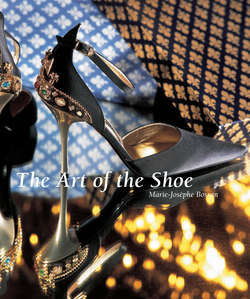Читать книгу The Art of the Shoe - Marie-Josèphe Bossan - Страница 12
На сайте Литреса книга снята с продажи.
From Antiquity up to our days
Rome
ОглавлениеRome was the direct heir to Greek civilization and felt its influence in the area of footwear: Roman shoes are mainly imitations of Greek models.
In ancient Rome, shoes were indicators of social status and wealth. Some patricians wore shoes with soles of silver or solid gold, while plebeians were content to wear clogs or rustic footwear with wooden soles. Slaves lacked the right to wear shoes and walked barefoot, their feet covered in chalk or plaster. When high-ranking Roman citizens were invited to a feast, they had someone carry their sandals at the home of their host. The less fortunate had to carry their own shoes, because it was considered rude to keep ones walking shoes on. As a bed was used for dining in Rome, shoes were removed before the meal and put back on when leaving the table.
Roman shoes fall into two categories: the solea, a form of sandal, and the calceus, a closed toe shoe worn with a toga. Other types evolved with variation in colour, form, and construction. Magistrates wore strange-looking shoes with curved toes made out of black or white leather and decorated on the side with a gold or silver crescent. As in Egypt and Greece, the difference between the left and right foot was well differentiated. Shoemakers were citizens who worked in shops, rather than slaves. This is a crucial distinction in understanding the status of the shoe as an object.
In ancient Rome, the shoe began to acquire much importance in the military arena. The caliga, the Roman soldier’s shoe, was a type of sandal. Strapped to the foot, it had a thick leather sole with pointed studs. It was up to the soldiers to acquire the studs; under certain circumstances, however, they were distributed free of charge as part of a ceremony called the clavarium.
It is said that as a child the Emperor Caligula was so fond of wearing the caliga he was named after the shoe, a delightful and telling anecdote. The mulleus, a closed shoe that was red in colour, differed little from the calceus. Worn by emperors, magistrates, and the children of senators, it got its name from the seashell from which bright crimson was extracted. The campagus took the form of a boot that exposed the foot. Trimmed in fur, and often decorated with pearls and precious stones, it was intended for generals to wear. A crimson version was exclusively reserved for emperors.
As in ancient Greece, the sandal and the slipper were mainly intended for women to wear indoors. The soccus, a type of slipper with a raised tip and identical for both feet, was apparently of Persian origin; it would become a traditional shoe in Turkey. These delicate little shoes aroused the concupiscence of the era’s fetishists.
18. Low-relief of the Trajan column, soldiers of the Roman legions (military shoes). Rome, 113 AD. Marble.
Suetonus (70–128) tells how the Roman senator Lucius Vitellus, who carried under his tunic the slipper that his mistress wore on her right foot, without the slightest embarrassment, would remove the shoe in public and cover it with kisses. Red shoes had long been the privileged attribute of Roman courtesans before all women dared to wear them.
After the emperor Aurelius (212–275) wore them, red shoes became an Imperial symbol, giving birth to a tradition that was later taken up by the Papacy, and subsequently by all the courts of Europe, which wore red-heeled shoes.
We know from the writings of Juvenal (55–140) that to give a spanking with a shoe was a serious punishment commonly administered to children and slaves.
Romantic Romans put their shoes to more gallant use by inserting amorous messages between the sandal and the foot of their confidant. In this way, sandals became a drop box for love notes as advocated by Ovid (43 BC-17 AD) in The Art of Love.
19. Colossal statue of the god Mars (shod in campagus). 1st century AD. Capitole Museum, Rome.
20. Funerary stele of a cobbler. Reims, Marne, faubourg Cérès, Gallo-Roman, 2nd century AD. Collection of the Saint-Rémi Museum of Reims. Photo by Robert Meulle.
21. Sliver sandal. Byzantine period. Bally Museum, Schönenwerd, Switzerland.
